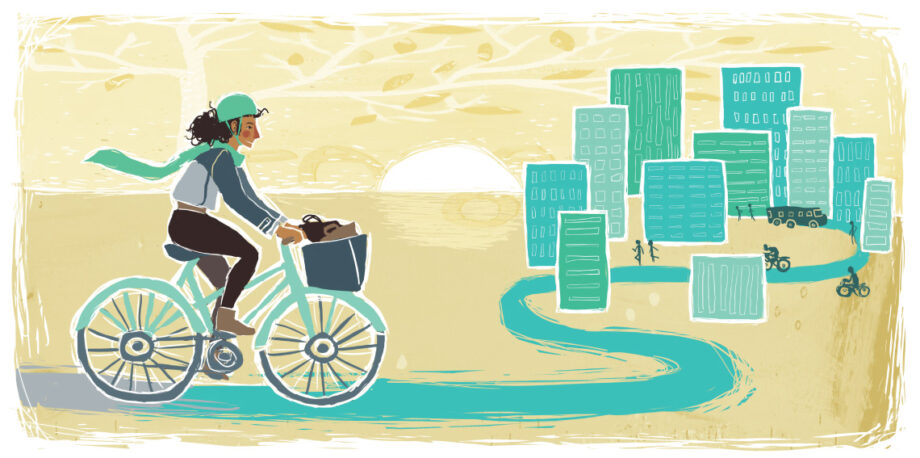August 20, 2013 — U.S. transportation planners are currently busy playing catchup to a new reality: People just aren’t driving as much as they used to. Recent studies suggest that miles driven peaked in 2004 — well before the economic downturn hit the United States. In 2012, vehicle miles traveled per capita dropped again almost a half percent, now the lowest driving miles per capita since 1996. So what’s driving the change? A whole host of factors, it turns out — everything from better public transit to high gas prices to an aging population.
But dig a little deeper into the research and you’ll find an interesting nugget: A lot of young people aren’t interested in driving. Research published in May by U.S. PIRG bears this out. Not only are Americans driving less overall, Millennials — those born between 1983 and 2000 — are driving even less. In fact, “young people aged 16 to 34 drove 23 percent fewer miles on average in 2009 than they did in 2001 — a greater decline in driving than any other age group,” according to the research.
It’s a preference shift that has waves of impacts — culturally and economically. The half-acre suburban lot with the 40-minute commute doesn’t have the same appeal to our kids as it did for my generation; many of them want to live where they can walk or bicycle, hop on transit, and stay connected to the Internet while they get from point A to point B.
I differ from most of my peers in the Baby Boom generation (those of us born between 1946 and 1964). Since 1987, my wife and I have been a one-car family near a transit line. I’ve been able to choose a downtown location for my workplace and rely on a multimodal mix of bus, cab, bicycle, car sharing, bike sharing and carpooling. As my generation passed through its child-rearing and early-career years, it created the automobile-oriented society by driving more every day. But now, as retirement looms, even Boomers are beginning to drive less.
In comparison, my children — now in their mid-20s — aren’t dissimilar from their Millennial generation peers at all. Neither of them owns a car, nor do they want one. They share cars with housemates and plan their housing, school, work and entertainment around less dependence on cars.
The new reality is that with gas prices pushing $4 again, low-cost housing on cheap land at the outer edges of cities makes less sense to people fresh out of college. But it’s not just a financial decision. Even upper-income young people are choosing apartments and condos in cool, urban neighborhoods and close-in suburbs. U.S. PIRG also found that from 2001 to 2009, “young people (16 to 34 -years -old) who lived in households with annual incomes of over $70,000 increased their use of public transit by 100 percent, biking by 122 percent, and walking by 37 percent.”
“Peak driving,” the concept that driving will continue to decline, might be the most important concept for transportation planners to grasp over the next few decades. The shift toward other forms of transportation is a good thing for cities, but it poses a challenge: Is public investment in infrastructure keeping up? A recent New York Times article outlined the steps transit authorities need to take to meet new expectations. Based on subway rider surveys, young people want to live in urban areas, expect Wi-Fi on transit and want apps for up-to-the-minute train information. This is certainly different than 20 years ago.
Planners should look closely at these trend lines and give considerable thought to whether highway expansions and new freeway interchanges at the exurban fringe are a good use of public money. Using limited transportation investment dollars where they provide the most benefit requires new rigor in weighing the costs and benefits of investment alternatives, and smart transportation departments like Minnesota’s are moving boldly in the direction of better accountability. When planners factor the full costs of alternatives — including travel time, congestion, operating costs, emissions, public safety and maintenance — transit investment often looks better than highway expansion.
Increasing investment in public transportation, bicycling and pedestrian infrastructure, and intercity rail creates a broader range of transportation options as well as corridors of development for housing and neighborhoods that are good for walking, biking and transit, thereby strengthening urban neighborhoods that have what many young buyers are looking for. It also helps drive private investment in commercial districts. Transit corridors for light rail, streetcars, bus rapid transit and commuter rail create transit stops all along the way that attract private development many times greater than the price tag of the initial public investment.
Nothing is more important for the economic competitiveness of urban areas than to attract young people and grow the population of educated and talented folks — artists, entrepreneurs, innovators — the so-called “creative class” that Richard Florida told us about more than a decade ago. The most sought-after demographic for cities and companies is the 20- to 34-year-old age group, especially educated young people who can live wherever they choose. The metropolitan areas that attract the most talent win. It’s that simple.
It’s not that people will stop using cars. But we should get used to seeing dramatic demographic and preference shifts. Life with so much driving is beginning to seem like a burden rather than a freedom. ![]()
Editor’s note: The views expressed here are those of the author and not necessarily of Ensia. We present them to further discussion around important topics. We encourage you to respond with a comment below, following our commenting guidelines, which can be found here. In addition, you might consider submitting a Voices piece of your own. See Ensia’s “Contact” page for submission guidelines.
Ensia shares solutions-focused stories free of charge through our online magazine and partner media. That means audiences around the world have ready access to stories that can — and do — help them shape a better future. If you value our work, please show your support today.
Yes, I'll support Ensia!
